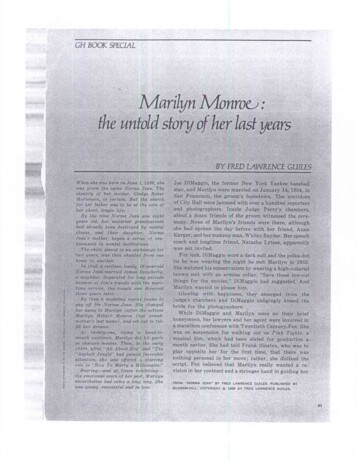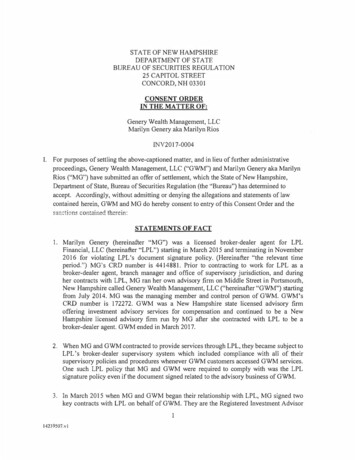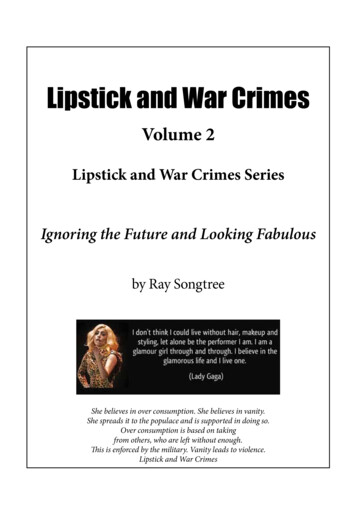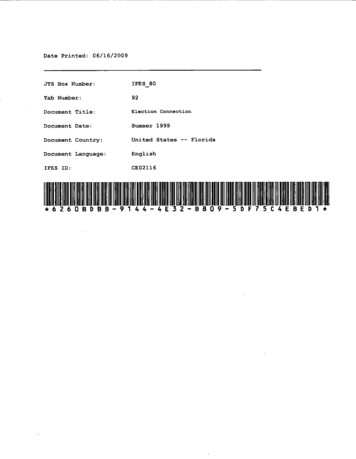
Transcription
GH BOOK SPECIALMarilyn Monroethe untold story of her last yearsBY FRED LAWRENCE GUILESWhen she was born on JUne 1, 1926, shewas given the name Norma Jean. Theidentity of her mother, Gladys BakerMortensen, is certain. But the search,for her father was to be at the core ofher short, tragic lifeBy the time Norma Jean was eightyears old, her maternal grandparentshad already been destroyed by mentalillness. and their daughter, NormaJean's mother, began a series of confinements in mental institutions.The child, placed in an orphanage fortwo years, was then shunted from onehome to another.In 1942, a restless, lonely, 16-year-oldNorma lean married James Dougherty,a neighbor. Separated for long periodsbecause, of Jim's travels with the maritime service, the couple was dieurcedthree years later.By then a modeling course began topay of for Norma Jean, She changedher name to Marilyn (After the actressMarilyn Miller) Monroe flier grandmother's last name), and set out to fulfill her rtrearns.At twenty-one, living a. hand-tomouth existence, Marilyn did bit partsin obscure movies. Then, in the early1950s, after "Al! About Eve" and "The"Asphalt Jungle" had gained farm-ableattention, she was offered a starringride in "How To Marry a Millionaire."Bearing—and at times exhibiting—the emotional scars of her past. Marilynnevertheless had come a long way. Shewas young, successful and in love.Joe DiMaggin, the former New York Yankee baseballstar, and Marilyn were married on January 14, 1954, inSan Francisco, the groom's hometown. The corridorsof City Hall were jammed with over a hundred reportersand photographers. Inside Judge Perry's chambers,about a dozen friends of the groom witnessed the ceremony. None of Marilyn's friends were there, althoughshe had spoken the day before with her friend, AnneBarger, and her makeup man, Whitey Snyder. Her speechcoach and longtime friend, Natasha Lytess, apparentlywas not invited.For luck, DiMaggio wore a dark suit and the polka-dottie he was wearing the night he met Marilyn in 1952.She matched his conservatism by wearing a high-collaredbrown suit with an ermine collar. "Save those low-cutthings for the movies," DiMaggio had suggested. AndMarilyn wanted to please him.Glowing with happiness, they emerged from thejudge's chambers and DiMaggio obligingly kissed thebride for the photographers.While DiMaggio and Marilyn were on their briefhoneymoon, her lawyers and her agent were involved ina marathon conference with Twentieth Century-Fox. Shewas on suspension for walking out on Pink Tights, amusical film, which had been slated for production amonth earlier. She had told Frank Sinatra, who was toplay opposite her for the first time, that there wasnothing personal in her move ; rather, she disliked thescript. Fox believed that Marilyn really wanted a revision in her contract and a stronger hand in guiding herFROM ' NORMA JEAN- BY FRED LAWRENCE GUILES. PUBLISHED BYMcGRAW-HILL. COPYRIGHT Cg 1959 BY FRED LAWRENCE GUILES.63
MARILYN MONROEw. continuedown career in films. Somehow it was settledand a temporary truce arranged with her salary adjusted upward. She even won her fightagainst Pink Tights, which was shelved permanently. For better or worse, she was winningmost of her studio battles now.Joe and Marilyn came back briefly to a handsome two-story house belonging to DiMaggio'sfamily in the Marina district of San Francisco.His sister, Marie, came in to handle the cookingand run the household. She had been discreetlytold by her brother that any time Marilynwanted to cook dinner, Marie was to just preend there was nothing unusual about it andet out of the way.Marilyn did lots of hiking up and down hillsway from the level Marina district. Joe, Jr.,dMaggio's son by his first marriage, came in:am school to meet his father's bride, and heLnd Marilyn went out to Seal Point and CliffHouse and then to the zoo, hard by the rockyshore of the Pacific.After this brief introduction to what wasntended to be her new hometown, Marilyn andArm.DiMaggio left on their wedding trip. DiMaggiohad agreed to go to Japan with Frank "Lefty"O'Doul, who had hired him as a rookie on theold San Francisco Seals. It was typical of DiMaggio to see nothing wrong in combining thatobligation with a formal wedding trip. O'Doulhad married only a few weeks before. Marilynand O'Doul's bride, Jean, could spend sometime together while the men visited the ballteams around Tokyo, Osaka and Yokohama,lecturing and appearing on television.Marilyn was determined not to let theircareers conflict. So this was to be DiMaggio'sbusiness trip and her wedding journey.The belated honeymooners flew first to Honolulu where they were mobbed by Marilyn's fans.They had neglected to seek any security againstthe public's wild enthusiasm. DiMaggio got afrightening taste of his future as the husbandof the most famous blonde in the world whenthe plane touched clown at Tokyo's InternationalAirport. Crying Illonchan (precious littlegirl) , hordes of "little Japanese" (as DiMaggiowas to remember it) came rushing toward them.4.1611414.L EI'.WTMI 5T OF pfFENSEThroughout her lifeMarilyn signed all officialdocuments (like I.D.curd for Korean trip)as "74:orma Jeone."rilyn and her!brated ballplayerband, Joe DiMaggio,aped off in Honoluluing IW wedding ?rip.This pose became atrademark for Marilyn'sfilm, "The Seven YearLich." But Joe DiMaggiowas inflamed by it.
Some threw flowers. Others reached out to touchMarilyn, several of them grasping at her hair.Marilyn's frozen smile masked her fright. Shefelt she was paying dearly for her reputationas the most monchan since Shirley Temple.The two couples settled into adjoining suitesat the Imperial Hotel. After a week or so oftrips by limousine to Fuji, religious shrinesand villages, the DiMaggios were invited to acocktail party given by the international set ofTokyo. There were numerous high-rankingAmerican army officers there. At one point, anofficer approached Marilyn and proposed thatshe consider a quick visit to the American troopsthen fighting for the United Nations in Korea.Marilyn was thrilled. DiMaggio was not. Hethought it could be pretty dangerous. "But it'sthe least anyone can do," Marilyn is reportedto have said, and DINleggin finally agreed.With Jean O'Doul and a contingent of brass,Marilyn was flown into Seoul where snowflakesswirled about the runway. From there she wasairlifted by helicopter toward the war area.Marilyn asked the pilot to fly low over thesoldiers on the ground so she might wave tothem. She managed this by lying face down onthe floor of the helicopter, lowering her bodyoutside the sliding door with two soldiers sittingon her feet.Several thousand marines cheered wildly asthe copter came down, and Marilyn was thrilledby the sight of them. Impromptu road signs inthe vicinity warned : "Drive carefully—the lifeyou save may be Marilyn Monroe's."With Jean O'Doul assisting her in the wings,Marilyn changed from an olive-drab shirt andskintight pants to an equally clinging gown ofplum-colored sequins. She was decked out withrhinestones to go with her first song, DiamondsAre a Girl's Best Friend. Although a bit wavery,fighting inadequate equipment and gusts ofwind, she sang her song. The wild enthusiasmof the soldiers carried her securely into thenext number.That evening, there was a dinner for Marilynin the General's Mess, a lavish arrangement ofseveral Quonset huts. The Signal Corps had arranged a telephoniccontinued on page /74VPIww NE4' On wedding 14ivekcied in1956, Marilyn and ArthurMiller joined Miller'sparents for happy portraitat Roxbury, Conn., farm.in Mail, 1962,,Pfarityn sang "HappyBirthday" to PresidentJohn F. Kennedy at NewYork's old MadisonSquare Garden.‘ .‘Inconsolable, JoeDiNaggio wept beforeMarilyn's crypt, inAugust, 1962. Joe. Jr.stood next to Dad.
MARILYN! MONROEcontinued from page 65greeting to her new husband back inTokyo. An embarrassing conversation,audited by the fifty guests, found Marilyn asking: "Do you still love me, Joe?Miss me?" In subsequent phone callsmade from her private tent that night,Marilyn begged DiMaggio to join her,but he explained that he had made somany commitments in Japan he couldn'tpossibly make it. The imbalance between the warmth and eagerness shownby Marilyn and DiMaggio's frequentbland lack of enthusiasm was to become more marked in ensuing months.Following that day, she cut down onher communications to her husband, letting him know only that she was allright. She basked in the most concentrated adulation of her entire career.As Marilyn's plane waited to take herback to DiMaggio in Tokyo two dayslater, she spoke to the officers andmen in the airport farewell party. "Thiswas the best thing that ever happenedto me," she said. "I only wish I couldhave seen more of the boys, all of them.Come to see us in San Francisco."Marilyn became feverish on the flightback to Japan, and by the time shereached the hotel her temperature hadrisen to 104 . The doctor diagnosed herailment as a mild form of pneumonia.She lay in the hotel room for four days,taking antibiotics and resting, with Joeto nurse and comfort her, and Jean andO'Doul for company. As memorable asher Korean visit had been (during thelast year of her life she was to sayagain that it was the high point in herlife), she was exhausted, and her briefstay in bed gave her time to thinkabout her career. She made up hermind about a couple of things. She wascertain that her acceptance of photographer Milton Greene's proposal thatthey form a new company, MarilynMonroe Productions, was the only wayshe could continue in films; and shewould try to make a go of it with DiMaggio in San Francisco.There was a quiet family celebrationupon their return to San Francisco andthe Marina house. Marie stayed on to runthings, and Marilyn didn't seem to mindthe arrangement. DiMaggio spent anhour or so every day at the familyrestaurant on Fisherman's Wharf, andMarilyn went with him a couple oftimes, but she became at once the focalpoint of all interest on the wharf andtourists came running.Some mornings, the couple would goout in DiMaggio's cabin cruiser, TheYankee Clipper. Marilyn wore slacksand a floppy hat and -huge dark glassesto keep her face from getting burnedby the hazy sun. One Sunday, DiMaggiodrove her to the small village acrossthe bay where he had been born overthirty-nine years before.San Franciscans respected Marilyn'sprivacy for the most part. Tourists, whosometimes outnumbered natives, wereanother matter. On one occasion,twelve-year-old Joe, Jr., had to fightoff a mob of out-of-towners who174seemed about to overwhelm them asthey debarked from a cable car. Marilynreceived a rebuke from DiMaggioabout this and agreed to move abouttown by car.Relieved of the pressures of Hollywood life and the tensions of courtship,the DiMaggios had a good, clear viewof each other. The first significantquarrels started in San Francisco. DiMaggio seemed to be sinking back intoa comfortable semi-bachelor existence.Sometimes neighbors would catch aglimpse of Marilyn standing alone onthe back patio at night wearing a lightraincoat and bedroom slippers.But DiMaggio's love for Marilyn wasso profound even he would not realizeits intensity until after he had lost her.When disillusionment moved in as anunwelcome third party, much of thegive-and-take of the early weeks oftheir marriage disappeared.tAtingioctStill vivacious despite her torment, Marilynappeared on set of 20th Century-Fox's"Something's Got To Glve," in June 62. Film,co-starring Dean Martin, wasn't released.A new film was scheduled for Marilyn, something the studio hailed as atribute to the songs of Irving Berlin.There's No Business Like Show Business was certainly a shopworn bouquetfor the composer, but Marilyn was to besurrounded by a clutch of expensiveentertainers, from Ethel Merman to thephenomenally popular "cry" singer ofthe period, Johnny Ray.Even though she knew the script tobe vastly inferior to Pink Tights,Marilyn suddenly agreed to return toHollywood. She and DiMaggio left SanFrancisco m April and found a rentedhouse on North Palm Drive in BeverlyHills.The "Elizabethan cottage" Marilynselected was not private. It was probably the most accessible of any star'shome—only three doors removed frombusy San Vicente Boulevard, It wasalso something of a mess. The lasttenant had neglected to clean it beforevacating, and the kitchen was filthy.Marilyn phoned her agent and closefriend, Inez Melson. "The kitchen's sodirty, it must he full of germs!" shewailed. "It will be terrible for Joe'sulcers!"His ulcers were worsening, but hiscondition had nothing to do with germs.Nevertheless, Mrs. Melson went to theempty house with her secretary andspent the better part of a day scrubbingdown the floors, walls and appliances.When Marilyn learned what they haddone she showed her gratitude by inviting Mrs. Melson to share their firstdinner, prepared by Marilyn herself.On the following Monday, Marilynwent back to the Fox lot to begin workon the musical. DiMaggio visited the setonly once—and Marilyn turned the occasion into an open-house. The gambleDiMaggio had taken already seemed tobe lost.With one movie finished in California, Marilyn headed East to make another. On the morning of September 9,1954, when the plane ramp was securedat Idlewild Airport in New York andthe door opened, Marilyn faced the mobbefore her with dismay. But she recovered quickly and beamed. Policehad set up barricades to keep the crowdback. Milling about in front of the police lines were dozens of photographersand reporters. This was the year ofMarilyn's romance with the public. Itwould not always be so.She had quarreled with DiMaggiobefore the plane left Los Angeles. Making films in California was one thing;making them in New York, he felt, wasquite another. He was faced now withMarilyn's location trip East for BillyWilder's The Seven Year Itch. DiMaggio insisted Marilyn was in a position tooppose studio heads who insisted onimprisoning her in a jazz-baby imageand forcing her to emote on the streetsof New York. For a terrible moment,Marilyn feared DiMaggio, who wouldjoin her later, would be there solely asa chaperon.Apparently, too, she was upset aboutone of his several business associations.DiMaggio had considered going into aholding company being set up by anindustrialist. The businessman hadsuggested to DiMaggio that it might behelpful if Marilyn would appear onoccasion at certain business affairsplanned by the new company. It hadtroubled her that DiMaggio had not declared himself opposed to the idea.She had learned to master the crowd,like the one waiting for her at the St.Regis Hotel, but she had failed to stillher private torments. This is not to sayshe had given up on DiMaggio, but theshrillness and indignation of her complaints to close associates, like theGreenes, were clues to the totteringstate of her marriage.Two days later, DiMaggio suddenlyappeared at the hotel. He made aneffort to keep out of the way of themovie in progress most of that weekend.
If DiMaggio believed that he couldtake things in hand, and see that Marilynwas treated with some dignity in herstreet scenes, which he correctly anticipated would be watched by thousands, he had overlooked his wife'sstiffening resolve. He had felt only atouch of it in California.Director Billy Wilder began his firstfilm with Marilyn with some knowledge of her previous behavior—herlack of punctuality, her disputes withother directors and studio heads, herneed for constant reassurance and herdifficulty memorizing lines. Their firstmeetings had gone well, though Wilderattributed what he called her fuzzyconnection with reality to some mentalmalfunction aggravated by alcohol.Since leaving San Francisco, she hadbegun drinking champagne to excess.But Wilder considered Marilyn anabsolute natural before the camera.And more importantly, he felt thefreshness of approach she brought toher work was the key to her attractionand to the audience's reaction.The day following the first day offilming, Marilyn was in conference withMilton Greene. Her rebellion againstthe film industry was now being committed to long legal forms of partnership creating Marilyn Monroe Productions.DiMaggio greeted Greene pleasantlyenough in the hotel suite, but thenwent off to the adjacent bedroom andturned on the television set.Around midnight, Marilyn was driven to the Trans-Lux Theater at 52ndStreet and Lexington Avenue. Thestudio had cordoned off the block, andcameras and lighting equipment weremoved in near the theater marquee.DiMaggio had come along, and Marilynwas silent and brooding. She wore asweater over her shoulders against thenight chill. Her costume for the sceneconsisted of a backless white dress witha pleated flounce skirt, white shoesand white panties, which would beplainly visible in one of the shots.Nearly a thousand New Yorkers werelined up behind a barricade at the corner. They had earlier watched studioworkers install a portable air blowerbeneath a subway grating in the sidewalk.DiMaggio kept out of the way of theactors and flim crew. His expressionwas grim, unsmiling; his hands werethrust into his pockets. Marilyn turnedher head once to catch a glimpse of himand appeared disconcerted for a moment, Then she moved over to thegrating and allowed the thrust of air totoss her flounced skirt well, above herknees. Shouts of "Hurrah!" could beheard from the spectators, then, "Higher! Higher!"DiMaggio appeared to turn to stone.While Marilyn rehearsed the scene withco-star Tom Ewell, DiMaggio retreatedto the other end of the block. He didn'tsee the newspapermen who had beenobserving him."What do you think of Marilyn having to show more of herself than she'sshown before, Joe?" one of them asked.DiMaggio had no time to disguise hisanger before those men. He shook hishead and walked away.Marilyn returned to the hotel aroundfour in the morning, exhausted by retakes and all the commotion at the location site. Apparently, DiMaggio returned at about the same time orshortly thereafter.Some shouting and scuffling, followedby hysterical weeping, was overheardby other hotel residents nearby. On thefollowing day, DiMaggio left for California.A few hours later, Milton Greenearrived with some papers for Marilyn togo over. He had to wait for her forquite a while, which wasn't too unusual, but when she did appear sheseemed distant. She was heavily sedated.When he began to discuss the intricacies of some of the documents,Marilyn was unreachable. Later, Greenelearned the source of her distress. Hermarriage was over.Don't let thishappen to youBe safe with a"Finger-Flick"Key TheftProtector"byUpon her return to Hollywood in themiddle of September, Marilyn retainedattorney Jerry Giesler, whose clientsalmost exclusively were film celebritieswho could afford his fees. Marilynwould no longer concern herself withbeing even slightly thrifty. Therewould be no more used cars, smallapartments, or clothes off a rack. Whenher money ran out, as it would on oneor two occasions, her debts would become mountainous. But, somehow,there would always be more money.Marilyn's agent and friend, InezMelson, was at the cottage early on themorning Marilyn's separation fromDiMaggio was announced. Inez realizedthat Marilyn was numb with emotionalfatigue.DiMaggio was in the house that lastday. He was able to bear Mrs. Melson'spresence with equanimity since heconsidered her a woman with decentinstincts. For her part, Mrs. Melson recalls that she felt terribly sorry forDiMaggio that day. "He seemed so lost,"she said, "so angry with himself. Notwith Marilyn, but with himself and withwhat was happening to them."Mrs. Melson was mercifully answering the phone and the door, turningaway reporters and callers she knewwere not dose to Marilyn, Her mind wasa catalog of Marilyn's preferences anddislikes. She had a somber and laconicnature. Perhaps that is how she managed not to get on DiMaggio's nerves.He must have known from Marilyn thatthe woman was not among the "leeches"who had attached themselves to theactress. Marilyn had ambivalent feelingsabout most of them; she knew some ofthem were bleeding her financially, butbecause of her insecurity she hesitatedto shake them off.When DiMaggio was completelypacked, his closest friend, RenoBarsocchini, loaded gear into the trunkof a Cadillac parked in the driveway.DiMaggio delayed making an appearance as long as he could. Outside weregathered about a hundred newspapermen. Finally DiMaggio emerged. Askedwhere he was going, he told reporters,Don't invite danger into yourhome! Police warn; never leavehouse keys with parking attendants. Always take house keys withyou when you park. So quick, easywith Finger-Flick. Just a flick of thefinger, house keys slide off. Another flick, they're locked back onagain. A "must" for womendrivers; a great gift forFather's Day and graduation. All initials. Only .For nearest jeweler:arm% CALL FREE800-243-0355(In Conn. call collect: 853-300)No charge for call, from anyplaceIn U.S., anytimeMAKE EXTRA MONEYSELL CHRISTMAS AHO ALT OCCASION CARDSWrappings Stationery Noire Gift ListOver 200 Name Imprinted Christmas Cards I0.11.“1 allMake Extra Money ForYour Organization Or YourselfNo experlenee needed. Orgeni cations, houeetelves, student.shut ine. others lino make blgprofit. to ISO% pine bone, Woo.Item& wli en sight. Cards worth250 or more Hell for len then70 each when bought by the hos .FREE gilt with first order.OVER 600 FAST SELLERSFREE ALBUMor Name ImprintedCHRISTMAS CARDS40 for 52.50 sigadditional3 Lines Arailatileto 569.00 per 100HEDENKAPAP, Dept. 5-67SAT Broadway, Haw York, N.Y. 10013Premse egad me .leak sample. on approval gMailfor 30 des/ trial. FREE Cater Catalog of over .400 Ilan. FREE Album at Noma Imprinted Coupon Christmas Gerd', Sole. Plan. FREE Gift Offer.TodayName .City, State, Zip Code.—175
"Back to San Francisco. That's myhome."Marilyn went back to work later thatsame week when shooting resumed onThe Seven Year Etch at the Foxstudios. Acting now was therapeutic,and director Wilder was relieved tofind Marilyn more engaged with herwork than before. Yet neither a happymarriage nor a crisis-relieving divorcewere to be any guarantee that allwould be well with Marilyn.Her break with Hollywood followedcompletion of The Seven Year Itch onNovember 4, 1954. Though she mayhave been anxious about the future,for now she was entirely on her own,her relief was great. Almost any wayshe looked at it, it seemed the mostintelligent move of her career.She declared herself "no longer contractually bound to Twentieth Century-Fox," and left it to her lawyers toargue the finer points.The next six years, in the East, made.up Marilyn's longest sustained effort tolive like a normal human being, onewith family ties and obligations, country places, and dose friends not involved in movies. When she laterreturned to her native city, she discovered she no longer fit in. Hollywooddoesn't accommodate itself to rebelseasily.In those closing weeks of 1954, Hollywood represented tyranny to Marilyn,while New York beckoned as the homeof her new friends, the Milton Greenes,one very important old friend, playwright Arthur Miller (whom she'd metin late 1950 when he had come Westwith his first screenplay), and the hopeof a new start in the industry withMarilyn Monroe Productions. In somemanner, possibly by phone, she hadbeen in touch with Miller.Marilyn flew to New York in earlyDecember. Although it was one of several new beginnings in her life, shewas still too frightened to feel revitalized. Nevertheless, the auspices forsome sort of fulfillment were more favorable now than ever before. Certainlyher status as a performer had improvedimmeasurably. Even the most acid ofher critics had to admire her courage.Marilyn's temporary stay in theGreenes' home was not without itshandicaps. She had never felt at homewith disciplined natures, and AmyGreene was the most organized humanbeing Marilyn had ever encountered.The Greenes lived in a spacious hilltop house in Weston, Connecticut.Marilyn delighted in it. She took longsolitary rambles over the acreage.When warm weather came, she attempted water skiing in Long IslandSound. During those months, she wasmore intimately aware of the out-ofdoors than she had been since her firstmonths as the young wife of Jim Dougherty.Greene and Marilyn had formalizedtheir partnership on the last day of1954, and that New Year's Eve therewere numerous toasts to the success ofMarilyn Monroe Productions. Therewere 101 shares of stock in the corporation, giving Marilyn 51 shares or a176majority interest. Later, when dissension and misunderstandings created abreach in their relationship, bothMarilyn and Arthur Miller, who had bythen become deeply involved in heraffairs, would feel she had been deceived by Greene over that division ofshares. The bylaws were written insuch a way that she had no controllingvoice in the affairs of her own company. The other officers were Greene'sassociates and she could be outvoted atany board meeting on any issue.But to understand why Greene was sodesperate to protect his own interests itis important to examine how extensivewas his stake in the corporation. Initially, the impact on his finances wasnut oppressive even though his originalpartner, a Wall Street man, had objected to the risk involved with Fox(which was threatening to sue them)and had pulled out. Greene purchaseda mild Broadway success, The SleepingPrince, by borrowing the money. Andwhen Marilyn began to assert her independence and insisted Greene findher an apartment in New York City, hewent more deeply into debt and subleased a small apartment for her in theexclusive Waldorf Towers.She kept much of her wardrobe atthe Greenes', but spent an increasingamount of time in the city. There wascontinuing newspaper and magazineinterest in her rebellion. In preparationfor her interviews, she visited hairdressers, dress salons and other shops.All of the bills went to Greene andsomehow they were paid.Marilyn could never remain isolatedfor an extended period. She went outof kilter after a time when all demands upon her were removed. Evenher interest in reading sagged whenshe found whole days yawning emptilyto be filled. She needed the pressure ofa busy schedule. Being busy mightmean she had only one important appointment, but she could devote asHANDCRAFTS TO MAKEFOR YOUR HOME(continued from page 112)Handcraft your own originals—ahas-relief plaque, a collage or floralpicture similar to those shown onpages 111 and 112. Complete directions for these three craft techniques are in the GH leaflet,Handcrafted Accessories. To orderit, use coupon below.Send order to:Good HousekeepingBulletin Service959 Eighth AvenueNew York, N.Y. 10019Enclosed is 35 cents. Please send meHandcrafted Accessories.NameAddressCityStateZIP Codemuch as three or four hours preparingfor it. She had to do everything unhurriedly or she went to pieces.Arthur Miller was coming into herlife and she was determined it wouldbe for keeps. Because of his children,Robert and Jane, Miller found it hard tomake the decision to break up hisfifteen-year marriage to Mary SlatteryMiller. There were secret meetingswith Marilyn at the homes of friendsin Manhattan and Brooklyn Heights.There were none at the Greene homein Connecticut. (According to Miller,he did not meet Greene until late 1955or early 1956.) Marilyn, sympathetic tothe needs of Miller's children, did notinsist upon an immediate rupture withhis family.As her interest in country life waned,Marilyn found New York a symbol ofpromise. What had begun as defianceof a movie studio had now become awhole new life.She felt little satisfaction in whatshe had done on the screen up to thattime. It was time to go on to somethingof more permanent value.There were occasional painful episodes induced by loneliness while shelived in her Manhattan tower. One ofthe worst occurred during the summer.Columbia Pictures had broughtTyrone Power and Kim Novak to NewYork to do location work on The EddyDuchin Story. Fred Karger, a closefriend of Marilyn's and her musiccoach, had come along to help with thefilm. With the stars of the film he wasin a suite on a lower floor of theWaldorf-Astoria, celebrating the conclusion of their New York shooting. Remembering that Marilyn lived in theTowers, Karger phoned her aroundeight in the evening. She told him shewould be down in half an hour; sheonly needed time to change.In an hour, when Karger called back,Marilyn's voice was fuzzy with alcohol,probably vermouth, which had becomeher favorite insulation when she wasfretful. Apparently the ghosts of herpast had revisited her after Karger'scall and she was trying to banish them.When, later, Karger went up to say goodnight, she was too far gone to care.When Marilyn dined out it was usually with some of Miller's friends intheir apartments: Norman Rosten,whose wife, Hedda, had become a goodfriend, and the Eli Wallachs. At one ofthese dinners Marilyn met the producerand director, Cheryl Crawford. MissCrawford became interested in Marilyn's ambition to make her reputationas an actress equal her reputation as apersonality. She spoke of the workbeing done at the Actors Studio andthought it might be a fine idea if Marilyn discussed her acting problems withits artistic director and leading teacher,Lee Strasberg.Strasberg, in studio classes, encouraged his students in such total involvement with self, with emotional memoryand experience, that they would oftenappear to outside directors as independent agents, unable to do a sceneuntil they grasped "the inner key."Strasberg also approved of his students
entering analysis, the better to discovertheir total inner selves. This emphasison self-involvement would be pivotalto Marilyn's future development bothon and off the screen.Marilyn's first lesson with Strasbergwas arranged. After she was comfortably settled, Strasberg began to baither with questions that hurt, that weredownright emba
GH BOOK SPECIAL Marilyn Monroe the untold story of her last years When she was born on JUne 1, 1926, she was given the name Norma Jean. The identity of her mother, Gladys Baker Mortensen, is certain. But the search, for her father was to be at the core of her short, tragic life By the time










